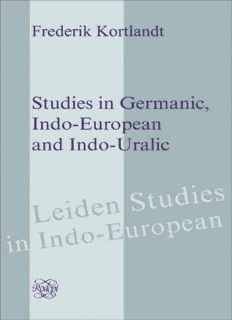Table Of ContentFrederik Kortlandt
Studies in Germanic,
Indo-European
and Indo-U ralic
Studies in Germanic,
Indo-European
and Indo-Uralic
17
LE!DENSTUDIESININDO-EUROPEAN
Series edited by
R. S.P. Beekes
A. Lubotsky
J.J.S. Weitenberg
Studies in Germanic,
Indo-European
and Indo-Uralic
Frederik Kortlandt
Amsterdam- New York, NY 2010
The paper on which this book is printed meets the requirements of"ISO
9706: 1994, Information and documentation-Paper for documents
Requirements for permanence"
ISBN: 978-90-420-3135-7
E-Book ISBN: 978-90-420-3136-4
©Editions Rodopi B.V., Amsterdam-New York, NY 2010
Printed in The Netherlands
To the memoryofDirk Boutkan (1964-2002)
CONTENTS
PREFACE •••••••••••••••••••••••••••••••••••••••••••••••••••••••••••••••••••••••••••••••••••••••••••••••••••••••••••••••••••••••• xi
INTRODUCTION
The spread of the Indo-Europeans ............................................................................. 1
General linguistics and Indo-European reconstruction ......................................... 7
On Russenorsk ............................................................................................................ 21
The origin of the Goths ............................................................................................. 27
C.C. Uhlenbeck on Indo-European, Uralic and Caucasian ................................... 31
An outline of Proto-Indo-European ........................................................................ 37
Schleicher's fable ........................................................................................................ 47
INDO-EUROPEAN PHONOLOGY
*H.o and *oH• .............................................................................................................. 51
Proto-Indo-European glottalic stops: The comparative evidence ........................ 53
Proto-Indo-European tones? .................................................................................... 67
An Indo-European substratum in Slavic? ................................................................ 73
INDO-EUROPEAN MORPHOSYNTAX
1st sg. middle *-H• ....................................................................................................... 81
Proto-Indo-European verbal syntax ......................................................................... 91
GREEK
Greek numerals and Proto-Indo-European glottalic consonants ....................... 10 5
The Aeolic optative .................................................................................................... n1
The Greek 3rd pl endings ........................................................................................ 117
INDO-IRANIAN
Glottalic consonants in Sindhi and Proto-Indo-European ................................. 121
Archaic ablaut patterns in the Vedic verb .............................................................. 125
Accent and ablaut in the Vedic verb ........................................................................ 131
The origin of the Indo-Iranian desiderative .......................................................... 139
viii Contents
TOCHARIAN
On the development of Proto-Indo-European fmal syllables in Tocharian ...... 143
The Tocharian word for 'woman' ............................................................................ 149
The fate of the sigmatic aorist in To char ian ........................................................... 151
A note on the Tocharian dual .................................................................................. 155
The To char ian imperfect ......................................................................................... 159
GERMANIC PHONOLOGY
Vestjysk st0d, Icelandic preaspiration, and PIE glottalic stops ........................... 165
Proto-Germanic obstruents ....................................................................................1 69
Kluge's law and the rise of Proto-Germanic geminates ........................................ 175
Labials, velars and labiovelars in Germanic .......................................................... 179
Preaspiration or preglottalization? ......................................................................... 185
Germanic *e, and *e• .................................................................................................1 89
Proto-Germanic obstruents and the comparative method ................................. 193
English bottom, German Boden, and the chronology of sound shifts ................ 197
GERMANIC VERB CLASSES
The Germanic first class of weak verbs .................................................................. 201
The Germanic third class of weak verbs ............................................................... 20 5
The Germanic seventh class of strong verbs ........................................................ 209
The Germanic fifth class of strong verbs ............................................................... 211
The Germanic sixth class of strong verbs .............................................................. 215
The Germanic fourth class of weak verbs .............................................................. 219
Old Norse taka, Gothic tekan, Greek rera:ywv ...................................................... 221
GERMANIC VERBAL INFLEXION
The Germanic weak preterit ................................................................................... 227
The Proto-Germanic pluperfect ............................................................................. 235
GERMANIC NOMINAL INFLEXION
a-
The inflexion of the Indo-European stems in Germanic ................................ 239
The inflexion of the Germanic n-stems ................................................................. 343
GERMAN
Old High German umlaut ...................................................................................... 2.47
The High German consonant shift. ....................................................................... 2.49
The origin of the Franconian tone accents ............................................................ 255
Contents ix
ENGLISH
The origin of the 0 ld English dialects ...................................................................2 59
How old is the English glottal stop? ...................................................................... 265
The origin of the Old English dialects revisited. .................................................. 26 9
Anglo-Frisian ............................................................................................................ 275
SCANDINAVIAN
The Old Norse i-umlaut. .......................................................................................... 285
On breaking. ............................................................................................................. 289
Glottalization, preaspiration and gemination in English and Scandinavian .... 293
Early Runic consonants and the origin of the younger fu thark ......................... 29 9
Bjorketorp and Stentoften ....................................................................................... 305
The origin of the vestjysk s1:0d ................................................................................ 313
Vestjysk st0d again ................................................................................................... 317
ALBANIAN
Proto-Indo-European *sin Albanian ..................................................................... 319
Proto-Indo-European *j in Albanian ..................................................................... 3 25
Reflexes oflndo-European consonants in Albanian ........................................... 329
ARMENIAN
Armenian ewl 'oif ..................................................................................................... 333
BALTO-SLAVIC
The Baltic word for 'in' ............................................................................................. 335
Alfs well that ends wel1 ............................................................................................ 337
Balto-Slavic accentuation revisited ......................................................................... 341
Lithuanian zinoti 'to know' ...................................................................................... 359
ITALO-CELTIC
More on the chronology of Celtic sound changes ................................................ 361
ANATOLIAN
Initiallaryngeals in Anatolian ................................................................................. 365
Hittite ammuk 'me' .................................................................................................. 369
Hittite hi-verbs and the Indo-European perfect ................................................... 373
Stative and middle in Hittite and Indo-European ................................................ 383
X Contents
INDO-URALIC
Eight Indo-Uralic verbs? .......................................................................................... 387
The Indo-Uralic verb ............................................................................................... 391
Nivkh as a Uralo-Siberian language ...................................................................... 405
Indo-Uralic consonant gradation .......................................................................... 409
Indo-Uralic and Altaic ............................................................................................. 415
Indo-Uralic and Altaic revisited ............................................................................. 419
APPENDIX
A parasitological view of non-constructible sets ................................................. 429
The origin and nature of the linguistic parasite .................................................... 435
REFERENCES .............................................................................................................. 439
INDEX ......................................................................................................................... 493
Description:The red thread which runs through this book is a quest for relative chronology of linguistic developments. The probability of a reconstruction can be judged against the background of the transitions which it implies for the linguistic system as a whole. The reconstructions are always bottom-up, neve

